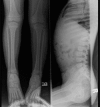3M syndrome: a report of four cases in two families
- PMID: 21911330
- PMCID: PMC3184518
- DOI: 10.4274/jcrpe.v3i3.30
3M syndrome: a report of four cases in two families
Abstract
3M syndrome is a rare entity characterized by severe growth retardation, dysmorphic features and skeletal changes as its major components. It is differentiated from other types of dwarfism by its clinical features and by the typical slender long bones and foreshortened vertebral bodies that can be visualized radiographically. 3M syndrome has an autosomal recessive mode of inheritance. An early diagnosis is important for genetic counseling. In this report, we present four children (3 males, 1 female) from two families who were aged between 4(11/12) and 10(11/12) years and had clinical findings of 3M syndrome. One of these patients had received growth hormone (GH) treatment which was discontinued due to an inadequate height gain. Physicians should be aware of this entity in the differential diagnosis of children with severe short stature and mild skeletal changes.
Figures






References
-
- Miller JD, McKusick VA, Malvaux P, Temtamy S, Salinas C. The 3-M syndrome: a heritable low birthweight dwarfism. Birth Defects Orig Artic Ser. 1975;11:39–47. - PubMed
-
- Hennekam RC, Bijlsma JB, Spranger J. Further delineation of the 3-M syndrome with review of the literature. Am J Med Genet. 1987;28:195–209. - PubMed
-
- Aglan MS, Ashour AM, Ramzy MI, Hosny LA, Mostafa MI. 3-M syndrome: a report of three Egyptian cases with review of the literature. Clin Dysmorphol. 2006;15:55–64. - PubMed
-
- Spranger J, Opitz JM, Nourmand A. A new familial intrauterine growth retardation syndrome. The 3-M syndrome. Eur J Pediatr. 1976;123:115–124. - PubMed
Publication types
MeSH terms
Supplementary concepts
LinkOut - more resources
Full Text Sources
Medical
Molecular Biology Databases
